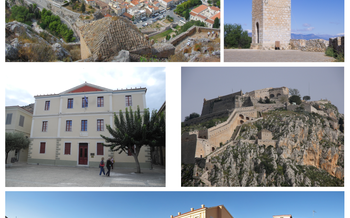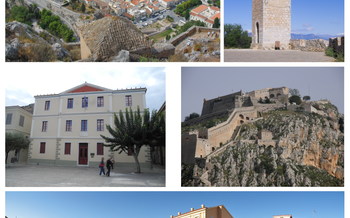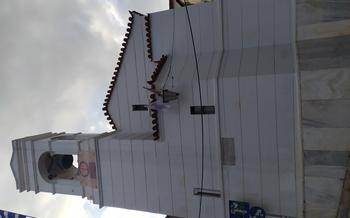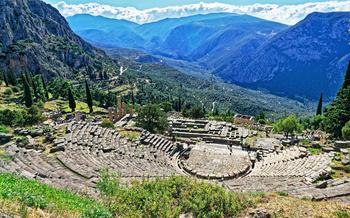
Komboloi Museum
- Historical Background
- An Overview of the Komboloi, a Traditional Greek Worry Bead
- Exploring the Museum's Collection
- Historical Significance
- Cultural Symbolism
- Manufacturing Process
- Unique Craftsmanship
- Interactive Displays
- Cultural Events
- Educational Programs
- Souvenir Ideas
- Tips for Visitors
- Nearby Attractions
- Insider Tip
Historical Background
Nafplio, a picturesque city nestled in the Peloponnese region of Greece, boasts a rich history that dates back to ancient times. During the Greek War of Independence (1821-1829), Nafplio played a pivotal role as the first capital of modern Greece. Its strategic location and natural harbor made it a vital stronghold for the Greek revolutionaries.
The komboloi, a traditional Greek worry bead, holds a significant place in the cultural heritage of Nafplio and Greece. Its origins can be traced back to the Byzantine Empire, where it was used by monks and clergy as a prayer tool. Over time, the komboloi evolved into a popular accessory among all walks of life, serving as a symbol of relaxation, contemplation, and personal style.
An Overview of the Komboloi, a Traditional Greek Worry Bead
The Komboloi, plural for kombolói in Greek, is a traditional Greek worry bead that holds a significant place in the country's cultural heritage. These handheld strings of beads, typically made from amber, wood, bone, or semi-precious stones, have been used for centuries by Greeks of all ages and social classes.
Komboloi come in various forms, each with its unique characteristics. Some are simple strings of identical beads, while others feature intricate designs and patterns. The materials used to make komboloi also vary greatly, from the glossy smoothness of amber to the rich hues of semi-precious stones like amethyst and turquoise. Regional variations exist, with different parts of Greece having their own distinct styles and preferences.
Exploring the Museum's Collection
The Komboloi Museum in Nafplio houses an extensive collection of komboloi from various eras and regions, offering visitors a unique opportunity to explore the rich history and cultural significance of these traditional Greek worry beads. Highlights of the collection include rare and antique pieces, such as finely crafted amber komboloi from the 19th century and exquisitely carved wooden komboloi from the early 20th century. Visitors can also marvel at the intricate designs and patterns showcased in the collection, ranging from simple and understated to elaborately decorated pieces adorned with precious stones and metals. The museum's displays provide detailed information about the materials, techniques, and cultural significance of each komboloi, allowing visitors to appreciate the craftsmanship and artistry that went into their creation.
Historical Significance
The komboloi holds a profound historical significance in Greek culture, deeply embedded in the nation's social fabric and history. For centuries, these worry beads have transcended their humble origins as mere prayer tools, evolving into multifaceted symbols of status, social class, and personal style.
In the past, the komboloi was a cherished accessory among the upper echelons of Greek society, a subtle yet potent indicator of social standing and affluence. The materials used, the intricate designs, and the overall craftsmanship of a komboloi spoke volumes about its owner's social position and wealth. Even today, the komboloi continues to carry this symbolic weight, albeit in a more nuanced and subtle manner.
Beyond its association with social status, the komboloi has also become an integral part of Greek personal style. It is not uncommon to see Greeks of all ages and backgrounds sporting a komboloi, whether as a fashion statement or as a comforting companion. The versatility of the komboloi allows it to complement a wide range of outfits and styles, from traditional Greek attire to contemporary fashion.
Cultural Symbolism
The komboloi, or Greek worry beads, has a deep cultural significance in Greece that goes beyond its practical use. It is an iconic symbol of Greek culture and tradition, representing various aspects of Greek identity and heritage.
In Greek Orthodox Christianity, the komboloi is often used as a prayer tool. During religious rituals, the beads are held in the hand and manipulated while reciting prayers. The tactile sensation of the beads is believed to aid in concentration and devotion.
The komboloi also holds social significance, serving as a symbol of status and social class. In the past, the type of komboloi a person wore could indicate their wealth, social standing, and even their political affiliation. Today, the komboloi is still considered a stylish accessory, and its design and materials can reflect a person's individual style and taste.
Furthermore, the komboloi has become a symbol of relaxation and contemplation. The rhythmic movement of the beads between the fingers is believed to have a calming effect, helping to relieve stress and anxiety. For many Greeks, the komboloi is a comforting companion that they carry with them wherever they go.
Manufacturing Process
The manufacturing process of komboloi is a fascinating blend of traditional craftsmanship and modern techniques. Each komboloi is a unique work of art, meticulously crafted by skilled artisans. The process begins with the careful selection of materials, which can range from natural stones like amber and jade to precious metals like gold and silver. Once the materials are chosen, the artisans shape and polish the beads using specialized tools and techniques.
The shaping of the beads is a crucial step, as it determines the overall look and feel of the komboloi. Artisans employ various methods to achieve the desired shapes, including carving, drilling, and tumbling. Carving is used to create intricate designs and patterns, while drilling creates the holes that allow the beads to be strung together. Tumbling is used to smooth and polish the beads, giving them a lustrous finish.
Once the beads are shaped, they are assembled into the final komboloi. The artisans carefully string the beads together using a durable thread or wire, ensuring that the spacing and tension are just right. The finished komboloi is then inspected for quality and any necessary adjustments are made.
The manufacturing process of komboloi requires patience, skill, and attention to detail. Each step is carried out with precision to ensure that the final product is both visually stunning and durable. The result is a unique and personal accessory that reflects the artistry and craftsmanship of the Greek people.
Unique Craftsmanship
The Komboloi Museum in Nafplio houses a remarkable collection of komboloi that showcases the unique craftsmanship and artistry involved in their creation. Each komboloi is a testament to the skill and dedication of the artisans who meticulously craft these beautiful objects. Visitors can admire the intricate designs, patterns, and colors used to create visually stunning pieces.
From the delicate carving of the beads to the intricate assembly of the komboloi, every step of the manufacturing process is carried out with precision and care. The result is a collection of komboloi that is both aesthetically pleasing and historically significant.
One of the most striking features of the Komboloi Museum's collection is the variety of materials used to create the beads. From precious stones like amber and jade to semi-precious stones like agate and turquoise, each material lends its own unique beauty and character to the komboloi.
In addition to the materials, the designs and patterns on the beads are also incredibly diverse. From simple geometric patterns to intricate floral motifs, each komboloi is a work of art in its own right. Visitors can spend hours admiring the intricate details and craftsmanship that went into creating these beautiful objects.
Interactive Displays
The Komboloi Museum features a variety of interactive exhibits and multimedia presentations that enhance visitor engagement and provide a deeper understanding of the traditional Greek worry beads. These interactive displays bring the history, cultural significance, and manufacturing process of komboloi to life, making the museum experience more immersive and enjoyable.
Visitors can engage with touchscreens to explore the different types of komboloi, their origins, and the materials used in their creation. Detailed videos and animations demonstrate the intricate manufacturing process, from bead shaping to assembly, showcasing the skill and craftsmanship involved in creating these unique objects.
Interactive kiosks offer visitors the opportunity to test their knowledge of komboloi through quizzes and games. They can also learn about the symbolism and cultural significance of komboloi, including their use in religious rituals and as a symbol of status and personal style.
These interactive displays not only provide information but also create a fun and engaging environment for visitors of all ages. They encourage exploration, discovery, and a deeper appreciation for the rich cultural heritage of Greece.
Cultural Events
The Komboloi Museum, in its commitment to preserving and promoting the cultural heritage of komboloi, organizes and hosts a variety of cultural events, demonstrations, and workshops. These events provide visitors with an opportunity to not only admire the museum's collection but also to actively engage with the art and tradition of komboloi making.
Demonstrations by skilled artisans showcase the intricate techniques and processes involved in creating these beautiful objects. Visitors can observe the transformation of raw materials into exquisite beads, witness the assembly of komboloi, and learn about the different designs and styles that have evolved over time.
Workshops offer hands-on experiences for those interested in trying their hand at making their own komboloi. Under the guidance of experienced instructors, participants can select materials, shape beads, and assemble their own unique creations. These workshops provide a deeper understanding of the craftsmanship and artistry involved in komboloi making and allow visitors to take home a personalized souvenir of their visit.
By organizing these cultural events, the Komboloi Museum not only celebrates the rich heritage of komboloi but also fosters a sense of community among enthusiasts and promotes the preservation and appreciation of this unique cultural tradition.
Educational Programs
The Komboloi Museum is committed to promoting the rich cultural heritage of komboloi through a range of educational programs designed for visitors of all ages. These programs aim to provide a comprehensive understanding of the history, symbolism, and craftsmanship associated with komboloi, while also fostering an appreciation for the unique artistry and traditions that surround this beloved Greek artifact.
For school groups, the museum offers guided tours tailored to different grade levels. These tours provide students with an interactive and engaging learning experience, allowing them to explore the museum's collection, learn about the manufacturing process of komboloi, and participate in hands-on activities related to komboloi making.
In addition, the museum regularly hosts workshops and demonstrations led by experienced komboloi artisans. These workshops offer participants the opportunity to learn the traditional techniques of komboloi making, from bead shaping and carving to assembly and polishing. Visitors can also observe skilled artisans creating intricate designs and patterns, gaining a firsthand appreciation for the craftsmanship and artistry involved in the creation of these beautiful objects.
Through these educational programs, the Komboloi Museum plays a vital role in preserving and promoting Greek cultural traditions, ensuring that the rich heritage of komboloi continues to be celebrated and appreciated by future generations.
Souvenir Ideas
The Komboloi Museum in Nafplio offers a range of unique and meaningful souvenirs that visitors can bring back home to cherish their visit to the museum and remember the rich history and cultural significance of komboloi in Greece. These souvenirs include:
-
Handcrafted Komboloi: Visitors can purchase handcrafted komboloi made with various materials such as amber, wood, gemstones, and semi-precious stones. These komboloi are often intricately designed and come in a variety of styles and colors, ensuring that visitors can find the perfect piece to suit their taste.
-
Komboloi-Themed Jewelry: The museum also offers a selection of komboloi-themed jewelry, such as necklaces, bracelets, and earrings. These pieces are inspired by the traditional komboloi and feature miniature beads or komboloi motifs, allowing visitors to wear a piece of Greek culture with them wherever they go.
-
Komboloi-Related Books and Publications: For those who want to delve deeper into the history and significance of komboloi, the museum offers a selection of books, publications, and catalogs that provide comprehensive information on the subject. These publications are authored by experts in the field and offer a wealth of knowledge for enthusiasts and collectors.
-
Komboloi-Themed Souvenirs: The museum also offers a range of other komboloi-themed souvenirs, such as keychains, magnets, and postcards. These items are perfect for visitors who want to bring back a small reminder of their visit and share their love of komboloi with friends and family back home.
Tips for Visitors
Before embarking on a visit to the Komboloi Museum, here are some practical tips to ensure a smooth and enriching experience:
- Plan your visit: Check the museum's official website or contact them directly to confirm operating hours and any special events or exhibitions that may be taking place during your visit.
- Consider a guided tour: Guided tours are an excellent way to delve deeper into the history and significance of the Komboloi Museum's collection. These tours usually provide expert insights and anecdotes that enhance the visitor experience.
- Dress comfortably: As you'll be spending time exploring the exhibits and potentially participating in interactive activities, it's advisable to wear comfortable clothing and footwear.
- Bring your camera: The Komboloi Museum offers ample opportunities for capturing beautiful photographs of the exhibits and the picturesque surroundings.
- Allow ample time: The museum's collection is extensive, and there's much to see and learn. Allocate sufficient time to explore the exhibits at a leisurely pace and engage with the interactive displays.
Nearby Attractions
The Komboloi Museum offers an excellent opportunity to learn about the history and significance of komboloi in Greek culture. However, Nafplio has much more to offer visitors interested in exploring the region's rich history and culture.
A short walk from the Komboloi Museum is the Venetian Fortress of Palamidi, an impressive fortification that offers breathtaking views of the city and the surrounding landscape. The fortress dates back to the 16th century and played a crucial role in the Greek War of Independence. Visitors can explore the fortress's ramparts, dungeons, and secret passages, providing a glimpse into Nafplio's rich military history.
Another must-see attraction in Nafplio is the Acronafplia, an ancient citadel located on a hill overlooking the city. The Acronafplia dates back to the 13th century and has served as a fortress, prison, and even a royal palace. Visitors can wander through the citadel's atmospheric ruins, taking in stunning views of the city, the harbor, and the surrounding countryside.
For those interested in art and culture, the National Gallery of Nafplio is a must-visit. The gallery houses a collection of Greek paintings and sculptures from the 16th century to the present day. Visitors can admire works by renowned Greek artists such as El Greco, Nikolaos Gyzis, and Konstantinos Volanakis, gaining insights into the development of Greek art over the centuries.
Insider Tip: For a truly unique experience, visit the Komboloi Museum during the annual Nafplio Komboloi Festival, held in September. The festival celebrates the art and tradition of komboloi making, featuring exhibitions, demonstrations, workshops, and live music performances. Visitors can browse stalls selling a wide variety of komboloi, from traditional to contemporary designs, and enjoy the lively atmosphere of this colorful cultural event.
Insider Tip
For an immersive and hands-on experience, consider attending one of the museum's komboloi-making workshops. These workshops provide a unique opportunity to learn the traditional techniques of komboloi making and create your very own personalized worry bead. Under the guidance of experienced craftsmen, you'll be able to select your preferred materials, design your own patterns, and assemble your komboloi, making for a truly memorable and creative experience.









